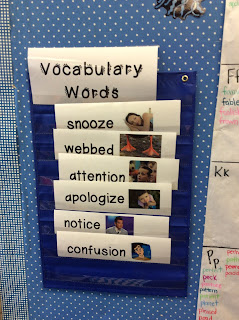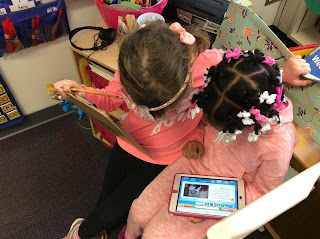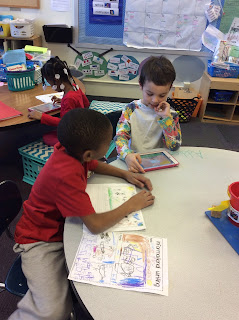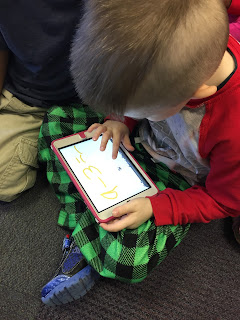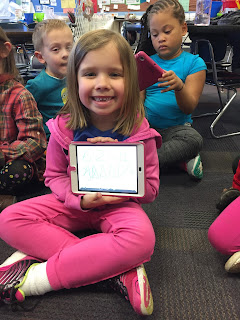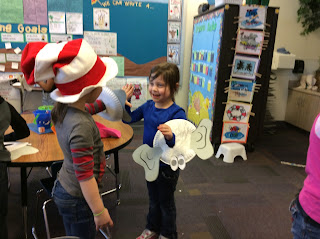Our CAFE strategies this week were review comprehension strategies, but we had an Accuracy focus strategy this week called “Flip the Sound”. Our word family this week was the -ake family. The “e” at the end of the words is a bossy E where it tells the vowel in the middle to say its name and not its sound...which in turn means to “flip the sound”. Have you ever taught your child a rule from the English language to then have them point out an example where it doesn’t work? Many words in the English language don’t follow basic phonics rules. For example, children learn that ch makes the /ch/ sound we hear in chip. However, this rule does not apply when decoding the word school. Children need to be given tools to use when reading so they are not stumped when common rules don’t apply. Flip the sound is a strategy good readers use when they come to a word that doesn’t sound right or make sense. Knowing the multiple sounds a letter or letter combination can make and being able to flip the sounds around is an essential skill.
How can you help your child with this strategy at home?
1. When your child reads a word incorrectly, wait until he/she gets to the end of the sentence. Then, stop your child and ask, “Did the word you just read sound right?” Put your hand palm-down and flip your hand over while saying, “Try flipping the sound.”
2. Remind your child that when good readers use the strategy of flip the sound, they listen for a word they recognize. They then check to make sure that word makes sense in the sentence.
3. When sounding out words, review the different sounds letters make. Ask your child, “What other sound could that letter make?” Encourage your child to use the strategy of flip the sound to try different words until he/she is successful.
4. If your child is still struggling with this strategy, give your child the kinesthetic prompt of flipping over your hand as a quiet reminder to try the strategy.
5. This strategy can be compared to the strategy of cross checking. Remind your child to look at the word and ask, “Does it look right, does it sound right, does it make sense?” If it doesn’t sound right, they will then know to flip the sound and try again
Our vocabulary words this week were:
- apologize
- confusion
- snooze
- webbed
- attention
- notice
We loved the book that went with the words this week and we focused on the word “apologize” later in the week. A few videos below show students practicing the word apologize with a partner.
Writing:
We continued to finish publishing our Pebble Go informational writing pieces by putting them into Book Creator. The class learned several fascinating facts about each of the animals they chose. We continued to use Pebble Go this week during our writing time by listening to a biography about Dr. Seuss. After we learned at least 3 facts about him, we completed a planning page to write down those facts and then entered them into a writing app called Write to the Core. This app allowed us to take a picture of our topic and write the sentences. After writing the sentences, it put them together on one page! We saved the writing as a photo and shared it to Google Classroom. A few examples of both the Pebble Go informational animal writing’s as well as the Dr. Seuss biographies are below!
Pebble Go Informational Writing Books
We reviewed previously taught skills this week. We focused on subtraction, greater than/less than/equal to and tens and ones. Students practiced each of these skills as a whole group, partner work and individually. I began testing these skills for the report card this week as well.
Our math vocabulary word(s) this week were review words from the previous weeks. We focused on “subtraction, minus, tens, ones and greater than, less than and equal to”.
Content:
This week was all about the author Dr. Seuss! We had so, so, SO much fun learning about him, reading his books, writing out him and more! Each day we focused on a different book and even had a theme to go along with it!
- Monday we brought a stuffed animal to school and read the story If I Ran the Zoo.
- Tuesday, we wore pajamas and read the story Dr. Seuss’s Sleep Book.
- Wednesday, we wore mismatched clothes and read the story Wacky Wednesday.
- Thursday, we wore crazy socks and shoes and read the story Fox in Socks and The Foot Book.
- Friday, we wore hats to school and celebrated the story The Cat in the Hat. Later that afternoon, we also learned about Horton Hears a Who and practiced saying kind words with a Horton craft!
Below are SEVERAL pictures and videos from our fun filled week!
PRACTICE AT HOME:
Practice rhyming words at home! You say one word in a word family or another word that could have a word that rhymes with it. The words the student comes up with can be real words or nonsense words. Try this saying " I say 'cat' you say 'rat', 'cat'--'rat'." and so on through several different words. A few we have studied so far are the -at, -og, -am, -ig, -ot, -op, -ake and several others.
Next Week:
- In reading we will focus on how characters change throughout a story.
- In writing we will finish up our unit on Informational Writing and begin weather reports.
- In math we will continue to focus on reviewing all 3rd nine weeks skills.
- Our theme next week is all about WEATHER!
Important Dates/Information:
- 3/15 and 3/17 Parent/Teacher Conferences--please return the day/time green paper I sent home confirming your conference
- 3/18 3rd Nine Weeks Awards Ceremony 2:00PM
- 3/ 21-3/25 NO SCHOOL SPRING BREAK
- 4/8 Spring Pictures
- 4/29 Spring Carnival
- 5/5 Muffins for Mom
- 5/10 Field Trip to Indy Zoo


